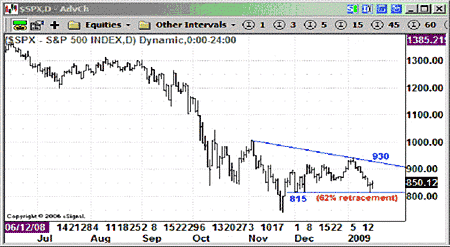Today, I figured I'd deviate from my regular format just a little and give you an update on where stock indexes could be heading over the shorter to intermediate-term.
Unfortunately, there's no concrete evidence yet that the bear market has ended. But it's a well-circulated theory that stocks normally make a longer-term low about six months before a recession ends.
Keep in mind, though, that nobody can tell for sure whether the worst of this recession is priced into the markets or not. So while it's important to remember that things are eventually going to look better, we don't yet know whether they'll get worse first.
MoneyWeek
Subscribe to MoneyWeek today and get your first six magazine issues absolutely FREE

Sign up to Money Morning
Don't miss the latest investment and personal finances news, market analysis, plus money-saving tips with our free twice-daily newsletter
Don't miss the latest investment and personal finances news, market analysis, plus money-saving tips with our free twice-daily newsletter
The not-so great eight
To set the scene for the current situation, recall that the major market indexes made their recent lows on November 21, 2008.
From that point until January 6, the S&P 500 index gained 20% until renewed selling hit the indexes again last week. And as of last Thursday afternoon, the S&P 500 had given back about 61% of the gains it accumulated since late November. That brought it to an important Fibonacci retracement level before stocks rebounded slightly during the rest of Thursday into Friday.
While my technical analysis is mainly based on pattern recognition, the major indexes have changed direction eight times since the November lows.
That kind of volatility back and forth makes for very complex chart patterns, which in turn makes them increasingly tough to interpret and forecast the next move.
But we'll take a whack at it anyway!
When a situation like this arises and one course of action fails, it's usually a good idea to consider another. So I'm going to use some different types of technical analysis today to try and get a handle on the market's future direction.
Watch the five waves
The Dow Transportation Index (^DJT) made its highs in May 2008, while the Dow Industrials made its highs in October 2007.
If you're familiar with Dow Theory, when the Industrials fail to keep pace with the Transports last May, it triggers a longer term 'Dow Theory' sell signal. And with both indexes making their recent lows on November 21, 2008, it means they're still on sell signals.
I've posted a weekly chart of the S&P 500 below. From what I can interpret, the pattern appears to be in an Elliott Wave 5-wave move down. The sharp velocity of the third wave down makes me believe that we're in for a 5-wave correction.

In keeping with using simpler technical tools, I suggest keeping an eye on the daily S&P 500 chart. So let's switch to that chart
You can see that the downtrend line comes in around 930, with support around the 815-point level. The index has already tested this point three times since the November low.

Here's the bottom line: A close or two below 815 should lead to a test or break of the November lows. Price acceptance above 930, should lead to higher prices, at least over the shorter term.
This article was written by Jim Stanton, Technical & Quantitative Analyst, for the Smart Profits Report, and was first published on Monday, 19 January, 2009.
Get the latest financial news, insights and expert analysis from our award-winning MoneyWeek team, to help you understand what really matters when it comes to your finances.
MoneyWeek is written by a team of experienced and award-winning journalists, plus expert columnists. As well as daily digital news and features, MoneyWeek also publishes a weekly magazine, covering investing and personal finance. From share tips, pensions, gold to practical investment tips - we provide a round-up to help you make money and keep it.
-
 ‘Why I have ditched my Help to Buy ISA for cash savings and the stock market’
‘Why I have ditched my Help to Buy ISA for cash savings and the stock market’Without the 25% bonus, my Help to Buy ISA is effectively redundant, says MoneyWeek writer Sam Walker.
-
 Is your inheritance tax allowance cut if you sell to downsize or sell your home to pay for care?
Is your inheritance tax allowance cut if you sell to downsize or sell your home to pay for care?Downsizing relief is a little-known benefit that could save your loved ones tens of thousands of pounds in inheritance tax after you’ve died.

